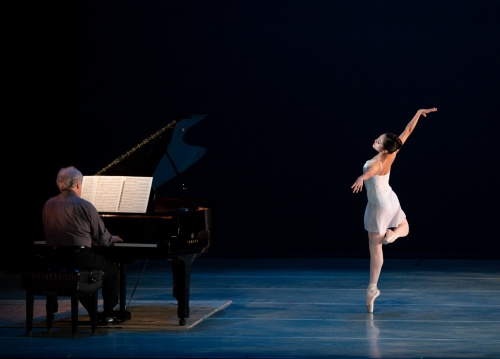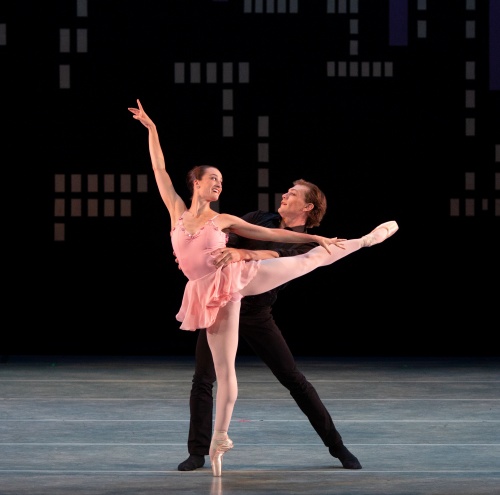|
 |
|
|
 |
 |
On September 27 on my way to The Toby Theatre at Newfields in Indianapolis for opening night of Indianapolis Ballet's “Evening of Balanchine,” I passed through the expansive Efroymson Lobby where 18 giant pastel-hued upside down ‘flowers’ hung from the ceiling and moving as I and others moved. Of course I lingered and marveled at the kinetic-sculptural art installation by the artist collective Studio Drift. The enchanting mechanics of "Meadow" remained with me in my seat as The Toby’s lights dimmed in pace with the opening strains of Tchaikovsky’s 3rd Piano Concerto, upon which George Balanchine built his enchanting "Allegro Brillante". When the curtain rose, I did a double-take— a swirl of pastel, as a visual echo of the grand main lobby wafted across the stage—floor-bound, of course— in the form of lady dancers, with comparable hues for the gentlemen. For whatever time elapsed until the lights snapped shut and the curtain fell, it seemed I didn’t stop breathing in the wonderment of brisk joyfulness shared through escalating and interweaving blinks of tranquility while in the company of a full house equally enthralled. As programming goes, this indeed was a brilliant stroke of embracing and extending the experience of an art installation with a staged ballet to mirror our connectivity with space, time and inner self. Whatever worldly worries I walked in with were mellowed by the seamless merging of music, movement and costuming. Romanticism invites us into such luxurious interludes, refreshing our body and soul from angst of headlines. Balanchine Trust repetiteur Melinda Roy fitted George Balanchine’s intent beautifully upon the Indianapolis Ballet's corps and principals, all within the sweep of splendor. The ladies taking turns in sets of four over the run of the production included: Indiana Cote, Camila Ferrera, Sierra Levin, Jessica Miller; Rowan Allegra, Buse Babadag, Abigail Rose Crowell, Dagney Hanrahan. John Beatrice, Greg Goessner, Glenn Kelich and Khris Santos. Kristin Toner and Riley Horton along with Yoshiko Kamikusa and Shea Johnson, alternated as principals. Of particular note regarding "Allegro Brillante," which New York City Ballet premiered on March 1, 1956, was Balanchine’s confession: “It contains everything I know about the classical ballet in 13 minutes.” It’s a breakneck piece. Blink and you lose a sequence illuminating intricate steps progressing into or coming out of sequence with the music. The pacing is daunting, yet this company, in its second full season, pulled it off with total delight. Tchaikovsky did not write this music as a ballet piece as was the case with his beloved trio: Swan Lake, composed in 1876, which IB presented in its premiere season 2018-19; The Sleeping Beauty, composed in 1890, which IB will present April 17-19, 2020; and The Nutcracker, composed in 1892, and which has been a staple IB production, first by the Indianapolis School of Ballet and since 2017 by the professional company. It seemed appropriate to imagine Tchaikovsky being pleased that this piano concerto would gain Balanchine’s attention as the epitome of romanticism—luxurious, uplifting, resilient. A re-use of a set-aside symphonic work, Tchaikovsky had scored the first movement early to mid-October 1893. November 6, he died from cholera, at age 53. While other composers’ final [or near final] works seemed to foresee their deaths, leaving us with requiems, Tchaikovsky’s unfinished 3rd Piano Concerto instead is a song of triumph of life lived in consort with one’s best sense of selfhood. Balanchine’s "Allegro Brilliante" is an affectionate tribute. Next, when the curtain rose for "Sonatine," the stage was swathed in soft blue light. A baby grand was at stage right. Silence. Pianist Panayis Lyras entered, acknowledged the audience and proceeded to play, eyes on music, oblivious to two figures entering, already wrapped into the intent of his playing. The dancers make a show of Maurice Ravel’s radiance, matching one-on-one movement to the music’s flowing breadth and growing depth coming at us in cyclical form. We watch intently—what surprise will surface next? How will they keep acting out in playful grand gestures without distracting this man at the piano—or are they trying to distract him? What really are they up to— a game between two friends, a mini-drama, a tete-a-tete we’re suddenly privy to? Music, movement escalate, how will this end—or won’t it? There’s something lingering and breathtaking in the music. Balanchine catches us by surprise. Yoshiko Kamiskusa and Chris Lingner on September 27 and 29, and Rowan Allegra and Riley Horton on September 28, each brought subtle personal dynamics to the interpretation. The first pair are liquid suave; the second pair imbue more of an airiness. The moves are the same; the bodies, nevertheless, inhabit them at their personal connectivity. The closing arc for each pair takes on a variant edgy nuance that defines their relationship leading to that extraordinary exit, her leading as he walks backward in the grasp of arms overhead. Silence. In the second movement, a minuet, the man re-enters. He’s in the music as a solo, as deep into his movement as is the pianist into his playing, and then as if drawn to turn, he sees her, is she real? an apparition? The minuet blossoms. Each pair brings its own glow into the concise radiance; each pair mocks my surety with their secrets. The third movement entangles all of us into brilliant piano virtuosity matched by powered dancing headlong into a totally unexpected ending. We stand and roar in delight. Balanchine Trust répétiteur Zippora Karz coached the dancers into living the next moment and taking us with them on their journey. Panayis Lyras, playing within Ravel’s desired finesse, equally embraced the music’s glow. Magical is what popped into my head, recalling the ethereal qualities of Balanchine dancer Violette Verdy, for whom this work specially was created, now being passed on to a third generation. Verdy had coached Indianapolis Ballet founder Victoria Lyras and fellow Pennsylvania Ballet dancer Jeffrey Gribler as guest artists with the then Indianapolis Ballet Theatre during their 1991-92 season. Panayis Lyras was on stage then too as the piano soloist. If act one filled us to overflowing WOW, act two tripled the WOW. Simply put, Balanchine created a divine candy and cakes shop of ballets on George Gershwin’s music, and each as delectable as the next. Why not feast when it’s a plenteous offering? Again credit Balanchine repetiteur Melinda Roy for the awe-inspiring ability to fit this demanding work onto the young troupe. The curtain rose to a scene of the New York City skyline, the stage already animated by the full IB company to a rousing "Strike Up the Band"; which immediately was followed by an ensemble of ladies deftly moving the slightly exotic, definitely bluesy “Sweet and Low Down” into sassy. It’s a surefire come on for the rest of the program to “grab a cab and come on downtown…” The ladies are fittingly fetching in swaggers, sways and knowingness. Off they go and are immediately replaced by a trio of ladies interlacing threads of discovery by a rotating cast that includes Indiana Cote, Anna Davis, Camila Ferrera, Dagny Hanrahan, Sierra Levin, Jessica Miller and Mary Ann Schaefer - “Somebody Loves Me/I Wonder Who?” Could it be one of the gentlemen acting out "Bidin’ My Time"? John Beatrice, Greg Goessner, Riley Horton, Shea Johnson, Greg Kelich and Khris Santos make up the bravura ensemble delivering double tours en l'air (turns in the air), one guy at a time, along with a host of other moves that gain an ovation. Balanchine sets us up with echoes of classical ballet segments inserted into this ‘take Broadway uptown show stopper’ that morphs directly into a story that skirts cliche and reveals what Balanchine truly is up to, because the pairings within a medley of "S’ Wonderful", "That Certain Feeling", "Do Do Do" and "Lady Be Good" rises above anticipated musical comedy to transform these familiar songs into Carnegie Hall verve. It’s a hint of what’s to come. The pas de deux for "The Man I Love" can break your heart with its aching understanding of what turns a break up into a lasting love. One wants to lift this quality off the stage into the heart—and head and gut. Balanchine gives the steps; the dancers execute with caring tenderness and gift us with their brilliance. Yoshiko Kamikusa paired with Chris Lingner on Sept. 27 and 28; Jessica Miller paired with Shea Johnson on Sept. 29. “I’ll build a stairway to Paradise
With a new step ev'ry day!
I'm gonna get there at any price;
Stand aside, I'm on my way!No stairway physically appears; Kristin Toner and Dagny Hanrahan take turns at different performances convincing us ascending is what we see, the rush of altitude is what we experience. They don’t mince-step, they strut, do rapturous turns and leap into their version of "Paradise". NPR posts a song newsletter. In 2008 "Embraceable You" was number one in the top five list for love songs. Trading off performances, Camila Ferrera and Chris Lingner, and Rowan Allegra and Shea Johnson, each prove the point with daring velvet moves. Fred and Ginger might have been the first to embrace this smile-maker, yet what these four bring makes the heart glow. It’s the facial expressions growing from genuine understanding of what’s at stake right along with the flow of the music that grows with fullness—and playfulness. What Yoshiko Kamikuska and Jessica Miller each do for "Fascinatin’ Rhythm", at alternate performances, can pump you up for the rest of a joyful life. Balanchine’s genius for communicating life force at its most delightful got its due on stage at The Toby. Never take anything for granted translates into small stuff that ignites into amazing expansiveness and bravura. Try stopping that speed of successive turns on a proverbial dime and into a show girl pose. That’s top-notch technique and a quality of self-trust. The audience acknowledged with loud and long applause. "Nothing much matters
So long as I care for you
And you care for me!”"Who Cares?" first surfaced in the musical, Of Thee I Sing, as a basic question, that answered itself. What do we have control over when we’re just ordinary people? Kristin Toner and Chris Lingner, and Dagny Hanrahan and Shea Johnson traded off performances to prove the point. "My One and Only" is a speed test to show everything you know about dancing in three minutes. Camila Ferrera and Rowan Allegra each scintillated at different performances. "Liza (All the Clouds’ll Roll Away)" debuted in 1929 in Florenz Ziegfeld’s musical Show Girl. Ninety years later, Chris Lingner and Shea Johnson, at different performances, gave us the continuum of exuberance of a marriage proposal. Balanchine’s choreography is tenderness and testosterone bundled into say ‘yes!’ Who could resist? The full cast leaped on-stage in groupings as a coda of all that appeared from curtain up, for the fulsome closing number, "I Got Rhythm". It’s a briskly paced tour de force, and really, “who could ask for anything more?” Be assured it will be answered at the next performance. Be prepared to stand and shout bravo, brava! Victoria Lyras and Loukia Finale created the costumes; James Leitner served as production designer and lighting designer; Paul Vitali is associate artistic director and ballet master; Carrie Reiberg is production manager, assisted by a corps of production volunteers.
 "Allegro Brillante"
(Center) Kristin Toner and Riley Horton
(L-R) Jessica Miller, John Beatrice, Anna Davis, Glenn Kelich, Khris Santos, Camila Ferrera, Greg Goessner, Indiana Coté Photo © & courtesy of Moonbug Photography |
|
 "Sonatine"
Yoshiko Kamikusa & Chris Lingner Photo © & courtesy of Moonbug Photography |
|
 "Sonatine"
Yoshiko Kamikusa
Pianist: Panayis Lyras Photo © & courtesy of Moonbug Photography |
|
 "Who Cares?"
Sierra Levin & Gregg Goessner Photo © & courtesy of Moonbug Photography |
|
 "Who Cares?"
Jessica Miller & Shea Johnson Photo © & courtesy of Moonbug Photography |
|
|
|






